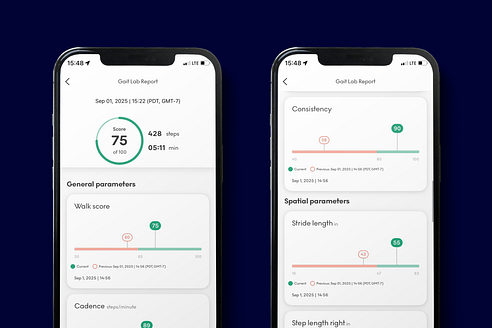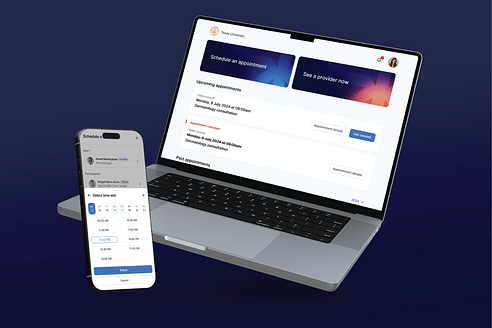
Revitalizing Rural Health: The Power of Digital Health

It’s 2022. In a South Dakota farming town, the local hospital is turning out the lights in the emergency room. Several Hospital Acquired Infections (HAIs)and discharge issues have led to the emergency department being put on diversion, which means patients will be diverted to another hospital 221 miles away. But closing the ED affects local patients in other ways. On the long ambulance journey to the other hospital, several mothers give birth and other patients die of injuries or medical events. When a high school student attempts suicide, there is no behavioral health unit and nowhere to hold him but a jail cell – which frightens another family so badly that they don’t know who to call when their daughter threatens to harm herself.
Now it’s 2025. The emergency department is lit, thriving, busy. The difference? A grant that allowed the hospital to launch a multidisciplinary digital health program. Now a woman who arrives at the hospital experiencing chest pains is treated by a cardiologist through a virtual consult. He refers her for blood work and an EKG, putting more revenue in the hospital’s coffers. Another patient is seen by a New York dermatologist, who diagnoses his melanoma and transmits critical healthcare data back to his primary care physician. Another patient arrives for her weekly virtual visit with a remote psychiatrist. The hospital’s SMS alerts have increased patient compliance with preventive care screenings and vaccine schedules – and because they’ve strengthened their financial viability through increased revenue, they host biannual community health fairs that educate patients on managing chronic conditions. The hospital is better able to meet quality measures as the community health improves – and they are successfully accredited by the Joint Commission.
The Growing Health Crisis in Rural America
We live in an age of shocking healthcare inequity. Access to life-saving care may partly be a matter of insurance, but it is also a matter of location. Rural communities face hospital closures and provider shortages; rural patients face long wait times for appointments and longer drives to specialty care. Rural facilities often can offer only limited services due to lower revenue, but the patients they serve typically have higher rates of chronic conditions and more complex needs than other populations.
Yet we also live in an age of technological sophistication. From virtual consults in disaster zones to AI tools that expertly triage patients, digital health offers innovative and sustainable solutions that can dismantle even stubborn barriers.
Challenges in Rural Health
Hospital closures
In recent years, rural hospitals have closed their doors at an alarming rate. One study found that lower profits, shrinking patient volume, and staffing challenges contribute to most of these closures. Those that remain open typically operate on thin margins, if not at a loss. Sparse populations mean lower patient volumes and less revenue; a higher percentage of rural residents are on Medicaid and Medicare, which typically reimburse at lower rates than private insurance. Healthcare organizations in remote locations can also pay higher costs for supplies and transportation.
Provider shortages
Clinician shortages are a national challenge, and they are most severe in rural and Tribal communities. For facilities, this means higher labor costs; for staff, it can mean longer shifts and burnout; for patients, it can mean long wait times for appointments and traveling hours for specialty care – or receiving no treatment at all.
Security vulnerabilities
With hospitals offering a rich source of valuable data, it’s not surprising that cyberattacks against the American healthcare system rose 128% in just one year. Just one attack can bring operations to a halt, stop life-saving care, and force facilities to pay a ransom to resume critical operations. Fraudsters know that rural hospitals have limited funds for a cybersecurity defense, making them a prime target for attacks.
Transportation burdens
In agricultural or rural communities, patients may live hours from the nearest clinic or hospital. An ambulance may not reach someone experiencing a medical event in time; patients below the poverty level may not be able to afford time off from work or childcare and transportation costs. The high cost of air medical transport can also saddle patients with catastrophic bills.
Privacy and stigma
In very small communities, many patients will know their nurse, phlebotomist, or other staff on a social level, making them worry about judgement or indiscretion. Patients who want treatment for chronic conditions or mental health challenges may hesitate to seek care in a close-knit community where everyone knows everyone.
Rural Health by the Numbers
Rural counties are more likely to face shortages of primary care doctors, dentists, mental health care providers, and even hospitals.
Nearly 1 in 4 rural citizens are on Medicaid; nearly half of all births in rural areas are covered by Medicaid.
38% of rural Medicaid enrollees under age 65 have a diagnosed chronic condition – and 22% have a behavioral health condition.
The number of rural counties classified as "older-age counties,” where more than 20% of their population are age 65 or older, has tripled since 2010.
88% of rural respondents are open to digital health visits.
93% of adults age 70 and older said they would like a telehealth option – and 86% had already had one virtual appointment in the past year.
After experiencing virtual consults, 96% of patients said it resulted in equivalent or superior overall medical care, and 78% reported it improved their access to health care services.
Rural Patients, High Risk Populations
Rural health challenges afflict patients of all backgrounds – but some of the most vulnerable patients are disproportionately represented in rural communities.
Seniors
The “graying of America” is especially pronounced in rural areas. Roughly 20% of rural residents are over the age of 65, compared with 15% in urban areas. The number of rural counties classified as "older-age counties" (more than 20% of their population age 65 or older) has tripled since 2010.
One factor is lower birth rates in rural areas; another is the ongoing migration of young adults to metros with more job and social opportunities. That migration includes young healthcare professionals. Just as rural seniors reach the age where they require more medical care, they may find older physicians are retiring and most younger physicians prefer to practice in more populated areas.
Mothers and Newborns
Provider shortages can lead to a lack of OB/GYNs, pediatricians, and certified nurse midwives – and a lack of labor and delivery units. In fact, more than half of all rural counties have no hospital obstetric services. These maternity care deserts contribute to worse health outcomes for mothers and infants compared to urban areas, as many women skip pre-natal care, which increases the risk of complications. Emergency departments increasingly serve as birthing environments, placing women in the hands of ED staff who may not be experienced in treating complications such as perineal tears, postpartum hemorrhage, or intraamniotic infections.
Native Americans
According to the 2020 U.S. Census, approximately 21.5% of American Indians/Alaska Natives reside in rural areas - a higher percentage than any other racial or ethnic group in the United States. While Native people are guaranteed healthcare by treaty, shortfalls in Indian Health Service funding can compound the impact of provide shortages and lack of equipment. This can lead to dire consequences, as Native people have higher rates of chronic liver disease, obesity, diabetes, cirrhosis, and cardiovascular disease than the general U.S. population. Yet resource-challenged environments may limit their ability to receive cardiac care, dialysis, and other services.
Veterans
Nearly a quarter of U.S. veterans live in rural areas. Elderly veterans are particularly concentrated in rural counties, often near military bases. Many experience service-related disabilities such as tinnitus, traumatic brain injury, respiratory illnesses, and chronic pain – yet the more rural they are, the less likely they are to live near a VA medical center or clinic.
Families Below the Poverty Line
Rural communities tend to have higher rates of poverty and uninsurance, along with food insecurity, and social determinants of health. Nearly 1 in 4 rural citizens are on Medicaid; nearly half of all births in rural areas are covered by Medicaid. But in the face of potential Medicaid cuts, this access to healthcare is precarious.
Digital Health: Repairing Ruptures in Rural Health
Digital health solves the above challenges, reducing costs, expanding access to care, improving continuity of care, and financially strengthening rural health systems in underserved areas. Its modalities are myriad; its impact acts as a force multiplier that successively transforms patient outcomes and facility revenue through exponential improvements.
The Rural Health Transformation Program capitalizes on these solutions by funding digital health modalities such as AI-assisted tools, Remote Patient Monitoring (RPM), and virtual consult capabilities. Such funding offers states a rare opportunity to achieve a quantum leap in healthcare improvements for rural Americans. By pairing advanced digital health platforms with intelligent deployment, states can create a more cost-effective and innovative healthcare system that connects all patients to top-tier care.
Digital Health: A New Blueprint for Rural Healthcare
Versatile, evidence-based, and technologically advanced, today’s digital health tools go far beyond simple video call visits. Beyond connecting the underserved to care, digital health unleashes a paradigm shift. Healthcare transitions from a disconnected series of episodic visits to a continuous and collaboratively managed journey that addresses patient needs across the continuum of care.
Digital Health Modalities
- Store-and-Forward (Asynchronous) tools can electronically transmit clinical data, images, or documents from one site to another without a live interaction. A busy specialist may not be available during a patient’s appointment – but a primary care physician can capture an image of a patient's asymmetrical mole and securely send it to a dermatologist for a diagnosis. A laboratory may digitize and submit a tissue slide to a specialist for analysis or a patient may send a picture of a healing incision to their surgeon.
- Remote Patient Monitoring (RPM) can track and transmit anything from a patient’s vital signs to glucose readings to cardiac activity, monitoring post-surgical patients or patients with chronic conditions. RPM can help reduce worsening conditions and hospital readmissions by addressing changes in a patient's health status before it deteriorates.
- Mobile health clinics bring dermatology screenings, mammograms, cardiac testing, immunizations, and other services to patients who would otherwise drive hours to brick-and-mortar clinics. Emergency Medical Technicians can augment their vehicles with digital health platforms that allow them to consult with specialists during emergent medical events such as stroke or heart failure – increasing survival rates.
- Patients can acquire their own clinic-in-a-pocket with health apps, fitness rings, and other wearables that track their own nutrition, heart health, weight, glucose levels, sleep cycles, and other health numbers, while receiving medication and appointment reminders.
Data-capturing devices work synergistically to collect and share advanced diagnostics and other information, allowing smarter collaboration between care teams, and making it easier for facilities to meet Joint Commission and CMS quality requirements.
Bridging the Rural Divide: 7 Benefits of Digital Health
Improved Quality of Care
Through triage and virtual appointments, digital health can reduce wait times in emergency departments and urgent care centers, free up exam rooms, and give staff more time for high acuity patients. Patients in smaller local hospitals can also connect virtually with specialists at a tier one hospital without the need to travel via a hub and spoke model. Because rural patients can receive a diagnosis and treatment faster, they can avoid worsening health outcomes. Their care teams also benefit from enhanced communication and coordination – avoiding missteps and unnecessary visits while integrating care.
Patient Engagement
Today’s patients are dissatisfied with the long wait times for traditional appointments. Younger patients, having grown up in the digital age, expect the convenience and accessibility of virtual care. But older patients request digital health options too; 93% of adults age 70 and older said they would like a telehealth option in one study – and 86% had already had one virtual appointment in the past year. The convenience of digital health can keep patients from bypassing their small local hospital for a tier-one hospital in the city by offering a sophisticated and appealing healthcare experience, while online portals and remote monitoring can help rural patients build deeper rapport with their care teams and foster a sense of ownership and power in their healthcare journey – encouraging them to engage with their care plans.
Reduced Travel Burden
Digital health enables patients to receive care close to home, reducing the need for patient transfers to distant facilities and keeping more hospital beds open for critical care. While this is vital, especially for Critical Access Hospitals (CAHs), who can manage complex patient cases locally with remote specialist support, it also helps patients avoid spending money on transportation, hotel rooms, and childcare, or missed work.
Increased Patient Capacity
Patient outmigration, where patients bypass their limited local hospital in favor of a top-tier hospital in the city, can hurt rural hospitals financially. Connected care allows hospitals to serve more patients without physically expanding their brick-and-mortar footprint. Instead of hiring an on-site physician for part-time needs, small hospitals and rural areas can access medical expertise only when they need it. States can also load-balance patient capacity, ensuring no provider lacks patients or that another is overwhelmed by too many. Instead, patients are allocated to providers across counties, keeping billability within the state.
Cost Savings
Digital health can reduce administrative overhead and reliance on locum tenens staff while optimizing resource utilization. In-person and ED visits are reduced; patient revenue increases through downstream in-network referrals to lab, pharmacy, and other services.
Solving Staffing Shortages
Even hospitals that have difficulty recruiting – or affording – full-time specialists can help their patients access specialty care in teleneurology, telecardiology, behavioral health, and other clinical disciplines. Bringing in remote physicians for overnight coverage or clinical support for on-site advanced practice providers can lighten provider burnout, increase provider efficiency, and improve staff retention as well.
Chronic Disease Management
Remote Patient Monitoring (RPM) can save lives in rural communities, which suffer from higher rates of diabetes, heart disease, and cancer. Providers can monitor a patient's health metrics from a distance – and because they receive ongoing data, they benefit from a fuller picture of a patient's health as opposed to being limited to a patient’s account during a 15-minute office visit. Potential issues are detected earlier; preventive care is accelerated; complications and hospitalizations are reduced, while patterns over time can steer providers to adjust medications or offer lifestyle education when a patient’s glucose readings, weight, or blood pressure readings suggest it.
GlobalMed: Connecting the Underserved to Quality Care
With over two decades of experience in building and deploying digital health solutions, GlobalMed has facilitated over 60 million virtual visits in more than 60 countries. We’ve partnered with Veterans Health Administration, Defense Health Agency, the Bureau of Prisons, the Florida Department of Emergency Management, California Department of Corrections, and others to deploy powerful and cost-effective digital health programs throughout the continental United States. From Great Plains farming communities to Native American reservations to veterans’ hospitals, GlobalMed has solved rural health problems for more than 23 years.
With a fully integrated platform that combines software, hardware, and data-capturing devices, GlobalMed unlocks evidence-based digital health for any location - and we meet two commitments in every engagement.
- We customize our solutions to your needs.
Our all-in-one platform is modular and flexible, scaling easily to fit into any health setting or program. After GlobalMed assesses a partner’s clinical and operational needs, we design specific solutions that are as customized and individualized as the client requests. Teams can start small and build their digital health program over time, tailoring it to their facility needs and expanding as their needs evolve.
- We support you from strategy to system integration to long-term success.
To ensure smooth rollout and adoption, we provide white-glove training on both technological proficiency and integration into existing workflows. We support our partners through every step of their digital health journey, with trained staff available to troubleshoot any problems, to help them maximize the benefits of our solutions and implementation.
The GlobalMed Advantage: Access to quality care - anywhere
Accelerated Delivery of Care
Our secure digital health platform connects patients in even the most remote environments to healthcare providers when they need it. Patient-directed triage and an AI-driven symptom checker expedite assessments and prioritization to connect patients to targeted care. Mobile providers using portable digital health tools can count on telementoring support, just as rural clinics can rely on remote specialist mentoring. The result: rural Americans receive timely care even in low-resource communities, from low-acuity video visits to high-acuity, specialty, and complex care scenarios.
Evidence-based care
Our software and our devices are purpose-built for evidence-based care. From ultrasounds to ECGs to stethoscopes, our platform collects and shares the data providers need for diagnostic accuracy and powerful collaboration at the point of care. Our ability to digitize patient data and seamlessly integrate into an Electronic Health Records (EHR) system further improves quality and continuity of care.
Rural facility support
Data is the beating heart of the GlobalMed platform. Our analytics monitor facility risk to keep performance high and quality measures on track, while our centralized system keeps medical records easily accessible and up to date for smarter care coordination. Our eNcounter software was designed from the ground up to help rural hospitals remotely bring specialists into consults to support their outlying clinics in a hub and spoke style system, while rural clinics can evolve into a rural tele-urgent support node. Downstream referrals help to keep patient care in the community, increasing revenue for small hospitals.
Chronic disease interventions
Our remote monitoring capabilities have empirically reduced readmissions for post-operative patients and helped patients better manage their chronic conditions between physician visits, preventing complications and reducing hospitalizations.
Clinical versatility
GlobalMed capabilities are specialized and diverse, with more than 55 modalities of medicine to address specific conditions. Medical devices such as exam cameras, digital stethoscopes, ultrasound probes, ECG, spirometry equipment, and clinical stations work together to help care teams provide evidence-based care, track facility performance, and meet Joint Commission and CMS requirements. Our teletherapy modality supports patients’ mental health through virtual therapy sessions.
Patient convenience
Patients can receive care from their own home, erasing the need to travel for diagnosis or care; to schedule appointments, they can select the available providers and time slots that best accommodate their schedule. RPM can foster more personalized and proactive relationships between providers and patients, deepening trust and encouraging patients to adhere to treatment and make any necessary lifestyle changes.
Mobile health
Our modular solutions fit elegantly into mobile clinics and units, which can bring women’s health services, dermatology screenings, vaccinations, disaster zone care, and other care to rural and border communities. In some towns, our solutions have empowered pop-up clinics to operate on a consistent timetable, allowing patients to schedule care as needed. Other patients even receive primary and specialty care in their own home, thanks to our transportable exam stations.
Connectivity on demand
Broadband and infrastructure challenges have limited other digital health deployments in rural areas - but GlobalMed solutions include robust broadband connectivity, ensuring quality and reliable uptime in virtual visits and remote patient monitoring. GlobalMed solutions have delivered top-tier medical care across the Digital Divide, including Native tribes at the bottom of the Grand Canyon, farming communities without a nearby hospital, disaster zones, and battlefields.
Interoperability with health information technology (HIT) systems
Our applications and devices work together to integrate seamlessly into other technologies and levels of care, integrating with HIT systems such as EHRs, practice management platforms, and public health networks through a sophisticated API that ensures a smooth exchange of data. Every patient encounter is securely documented and seamlessly integrated into the appropriate health record system, to ensure efficient care coordination while providers collect the data they need for clinical decision support and continuity of care.
Federal-grade security
SOC 2 and HIPAA compliant, GlobalMed has the Authority to Operate (ATO) on U.S. Department of Defense networks. Users can count on encrypted data transmission, secure connections, technical safeguards, stringent audit controls, and protocols for breach notification – a level of security that is critical for rural hospitals without a strong cyber defense program.
AI triage
Our AI triage tools can connect patients to appropriate providers hat determine the appropriate level of care needed – reducing non-critical visits to emergency rooms and accelerating chronic care interventions.
Intuitive interface, ongoing support
Simple and streamlined, GlobalMed solutions are easy to use for both patients and providers, so they can quickly connect and focus on the healthcare encounter rather than the equipment. Fast deployments, full training, and ongoing support ensure staff experience the maximum potential of their solutions for years to come, supporting program sustainability.
Rejuvenating Rural Health: 6 Success Stories
Texas Tech brings teledermatology to the Panhandle
The Texas Panhandle has some of the highest melanoma rates in the state. Skin cancer is common – but many towns are three or four hours away from the nearest dermatologist in Lubbock. Appointments must be booked up to a year in advance. Texas Tech University Health Sciences Center (TTUHSC) created a teledermatology program using GlobalMed’s Transportable Exam Station (TES) unit, TotalExam® 3 camera, and other tools to connect rural towns to expert care. They have reduced appointment wait times from one year to one week, eliminated appointment travel times of four hours or more, and partnered with school districts to teach preventive care to children. They’ve also increased detection rates of skin cancer, alopecia and other conditions – and provided emergency interventions and admitted patients to hospitals for life-saving treatment.
Key Highlights:
- Reduced appointment wait times from 1 year to 1 week
- Eliminated travel times of 4 hours+
- Increased skin cancer detection rates
The Veterans Administration connects veterans to audiology and behavioral care
Bringing care to rural veterans has long been a challenge for the VA. One young veteran in North Dakota was diagnosed with CPTSD, but his local Community Based Outpatient Clinic (CBOC) lacked behavioral health services. Instead, he was forced to drive hours to see his provider, something that could be dangerous in the brutal Great Plains winters. The VA’s National Telemental Health Center utilized GlobalMed solutions to connect veterans to expert behavioral healthcare – and the veteran was able to see a psychiatrist from his own VA Community Based Outpatient Clinic (CBOC).
At the same time, the VA launched a successful teleaudiology program. Tinnitus and hearing loss are the top two service-connected disabilities among veterans, with more than 2.7 million currently receiving disability benefits for those conditions. Using GlobalMed solutions, veterans can access self-administered hearing and speech tests, even when no audiologist is available in their area. An automated collection of diagnostic data and ear images is integrated into a single report, which is sent to an audiologist who might place an order for hearing aids or decide the veteran needs further testing.
The VA now uses virtual care across many disciplines, reducing hospitalizations for mental health patients, heart failure, hypertension, diabetes. and COPD – all adding up to considerable cost savings.
California lowers cost of inmate care
California Correctional Health Care Services (CCHCS) operates a state-run correctional managed care telemedicine program to provide better healthcare to inmates and reduce outside medical visits. Inmates remotely receive primary care and expertise in more than 30 medical specialties, including cardiology, dermatology, gastroenterology, HIV, infectious disease, nephrology, orthopedics, pulmonology, rheumatology, urology, and many more. Administrators have increased public safety, decreased medical transportation costs, improved staff retention and recruitment, and procured better coverage during provider military and maternity leave.
The program expanded from 16,000 virtual encounters in 2010 to more than 70,000 in 2018. They expanded specialist access from 30 specialists in 4 locations to 200 specialists in 22 locations by 2018. The result: in one year alone, their cost savings on healthcare and transportation costs topped $25 million.
Key Highlights:
- 30+ medical specialties
- Better provider coverage, retention, recruitment
- Savings topped $25 million in just 1 year
Copper Queen brings specialty care to a small desert town
Bisbee’s Copper Queen Community Hospital is a 14-bed critical access hospital, 10 miles north of the Arizona-Mexico border. When they implemented GlobalMed solutions, they started with a telestroke program in collaboration with the Mayo Clinic in Phoenix. One patient was former Bisbee Mayor Jack Porte, who said Copper Queen’s telestroke service enabled him to walk within a few hours of a paralyzing ischemic event. The hospital has since added telecardiology, teleneurology, teleburn, telepediatrics, and other programs. The hospital’s teleconcussion program includes baseline studies of high school athletes so post-injury scans can be compared to diagnose concussions.
The program has saved the small hospital significant money, allowing them to keep their doors open. Because the hospital no longer has to transport patients with atrial fibrillation to hospitals in Phoenix or Tucson, their telecardiology program was able to generate more than $1.4 million in transportation savings and additional revenue in its first six months. The Copper Queen’s patient satisfaction scores: 90% among ER patients.
Key Highlights:
- More than $1.4 million in savings & revenue in first 6 months
- 90% patient satisfaction scores
Petrobras reduces costs, expedites care, for oil rig workers
On offshore oil rigs, illness and injury are expensive business. Typically, a worker must be flown to the mainland or a provider transported to the oil rig – both costly endeavors that delay care. Brazilian petroleum giant Petrobras solved this problem by collaborating with Hospital Israelita Albert Einstein, a teaching hospital in Sao Paolo, to provide remote care to workers on five production platforms. GlobalMed solutions send live diagnostic data to providers, helping workers receive faster care without an expensive air evacuation. Staff see more patients and increase billable services without increasing overhead, while Petrobras has saved hundreds of thousands of dollars in transportation costs.
In one year, the hospital conducted 965 telemedicine visits using GlobalMed solutions. The results were impressive: 93.2% of those visits led to patient discharge without an evacuation – and of those who did travel, 71.4% were able to take the less expensive non-urgent flights, minimizing risk for the patient and flight crew.
Key Highlights:
- Avoided $50K+ helicopter evacuations 93% of the time
- Minimized risk for patient and flight crew
- Higher worker productivity
Texas Corrections saves $780 million on prisoner healthcare
The Texas Department of Criminal Justice (TDCJ) operates more than 30 state prison facilities, most in remote areas. Using digital health, it collaborates with two of the state’s leading health sciences centers: Texas Tech University Health Sciences Center (TTUHSC) and the University of Texas Medical Branch (UTMB) to control costs while providing quality care to inmates. Before deploying its virtual health program, few physicians were willing to see inmates in person, due to security risks and isolated prison locations. Yet many inmates enter prison with chronic health conditions, while longer sentences have created an aging population who need extensive services. Transporting inmates out of the prison presents considerable security risks and expense.
Through digital health, TDCJ has reduced unnecessary medical tests and transfers to outside medical facilities, boosted preventive care, and successfully identified offenders who fake an illness or injury. 85% of Texas inmates stayed at the prison for their healthcare consultation, saving the TDCJ $780 million over 14 years.
Key Highlights:
- Reduced outside inmate trips by 85%
- Saved the TDCJ $780 million over 14 years
Your Partner in Digital Health
Discover the GlobalMed Difference
As the Rural Health Transformation Program begins to fund and expand the scope of digital health programs, rural hospitals and patients face a promising new era in healthcare. From VA clinics to agricultural communities, rural Americans who were born into a region of health disparities now face an opportunity to receive consistent, quality care; states can lower their healthcare spending while improving outcomes for their most vulnerable citizens.
As the industry leader in digital health solutions for rural environments, GlobalMed offers a powerful and cost-effective path to this new era. By pairing cutting-edge technology with deep operational experience, our digital health partnerships can redefine rural health and create a future where distance is no longer a barrier to exceptional healthcare.
Let's build a future of healthier rural communities. Connect with us to learn how our strategic partnerships can bring exceptional digital health solutions to your state.
About GlobalMed
The global leader in digital health, GlobalMed enables digital care across the world, bringing evidence-based healthcare to military installations, rural hospitals, underserved communities, and other remote areas. All-in-one software and hardware solutions empower providers to treat patients at any point on the continuum of care – lowering costs and improving patient outcomes from one platform. With over 60 million consults delivered in 60 countries, its platform provides the highest level of security in the industry. Founded in 2002 by a Marine Corps Reserve Veteran still serving as CEO, GlobalMed is proud to partner with Veterans Health Administration, Defense Health Agency, the Bureau of Prisons, and other agencies in the service of transforming rural healthcare across the United States.
480) 922-0044


